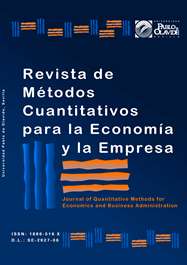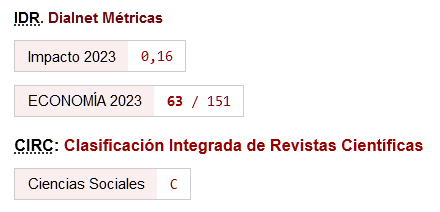Change Markets and Exchange Rates of Asia and Latin America: Long-Term Synchronization, Structural Changes and Stochastic Shocks
DOI:
https://doi.org/10.46661/revmetodoscuanteconempresa.2375Keywords:
tipos de cambio, Asia, Latinoamérica, cointegración, cambio estructural endógeno, impulso-respuesta, exchange rates, Latin America, cointegration, endogenous structural change, impulse-responseAbstract
The exchange markets and the exchange rates of Asia and Latin America are studied econometrically. Endogenous structural change and cointegration analyzes and impulse-response functions are used. The findings indicate that: 1) the long-term timing of the exchange markets is low; 2) there is no evidence of synchronization in Asian markets; 3) a stochastic shock in a Latin American country has effects of greater magnitude and duration than a similar shock in an Asian country; and 4) there is no evidence that the Global Financial Crisis has induced structural changes in the dynamics of exchange rates. The daily spot exchange rates of Argentina, Brazil, Chile, China, Colombia, South Korea, India, Malaysia, Mexico and Thailand are used for the period from August 5, 2002 to January 22, 2016.
Downloads
References
Agénor, P.R. y Montiel, P.J. (2015): Development Macroeconomics, Cuarta edición, Princeton University Press, Princeton.
Aggarwal, R. y Kyaw, N.A. (2005): “Equity market integration in the NAFTA region: Evidence from unit root and cointegration tests”, International Review of Financial Analysis, 14(4), 393—406.
Andrade, R.P. y Magalhães—Prates, D. (2013): “Exchange rate dynamics in a peripheral monetary economy”, Journal of Post Keynesian Economics, 35(3), 399—416.
Athukorala, P.C. y Rajapatirana, S. (2003): “Capital inflows and the real exchange rate: A comparative study of Asia and Latin America”, The World Economy, 26(4), 613—637.
Ayayi, R.A. y Mougoué, M. (1996): “On the dynamic relation between stock prices and exchange rates”, Journal of Financial Research, 19(2), 193—207.
Bahmani—Oskooee, M. y Saha, S. (2015): “On the relation between stock prices and exchange rates: A review article”, Journal of Economic Studies, 42(4), 707—732.
BIS (2016): Triennial Central Bank Survey: Foreign Exchange Turnover in April 2016, Bank for International Settlements, Basilea.
Canova, F. (2005): “The transmission of US shocks to Latin America”, Journal of Applied Econometrics, 20(2), 229—251.
Cenedese, G., Payne, R., Sarno, L. y Valente, G. (2016): “What do stock markets tell us about exchange rates?”, Review of Finance, 20(3), 1045—1080.
Chan, F. (2013): Advantages of Non-normality in Testing Cointegration Rank, Bankwest Curtin Economics Centre-Curtin University, Perth.
Chinn, M.D. (2012): “Macro approaches to exchange rate determination”, en James, J.; Marsh, I. y Sarno, L. (eds.): Handbook of Exchange Rates, John Wiley & Sons, Hoboken, 45—71.
Della Corte, P. y Tsiakas, I. (2012): “Statistical and economic methods for evaluating exchange rate predictability”, en James, J.; Marsh, I. y Sarno, L. (eds.): Handbook of Exchange Rates, John Wiley & Sons, Hoboken, 221—263.
Edwards, S. (2011): “Exchange—rate policies in emerging countries: Eleven empirical regularities from Latin America and East Asia”, Open Economies Review, 22(4), 533—563.
Eiteman, D.K., Stonehill, A.I. y Moffett, M.H. (2013): Multinational Business Finance, Décimo tercera edición, Pearson, Upper Saddle River.
Fama, E.F. (1970): “Efficient capital markets: A review of theory and empirical work”, Journal of Finance, 25(2), 383–417.
Frankel, J.A. (2004): “Experience of and lessons from exchange rate regimes in emerging economies”, en Asian Development Bank (eds.) Monetary and Financial Integration in East Asia: The Way Ahead Vol. 2, Palgrave Macmillan, Nueva York, 91—138.
Frankel, J.A. y Rose, A.K. (1995): “Empirical research in nominal exchange rates”, en Grossman, G. y Rogoff, K. (eds.): Handbook of International Economics Vol. 3, North Holland, Amsterdam, 1689—1729.
Frankel, J.A. y Rose, A.K. (1996): “Currency crashes in emerging markets: An empirical treatment”, Journal of International Economics, 41(3), 351—366.
Frieden, J. (2008): “Globalization and exchange rate policy”, en Zedillo, E. (ed.): The Future of Globalization: Explorations in Light of Recent Turbulence, Routledge, Abingdon, 344—357.
Imbs, J. (2004): “Trade, finance, specialization and synchronization”, Review of Economics and Statistics, 86(3), 723—734.
Johansen, S. (1991): “Estimation and hypothesis testing of cointegration vectors in Gaussian Vector Autoregressive models”, Econometrica, 59(6), 1551–1580.
Kaminsky, G.L. y Reinhart, C.M. (1998): “Financial crises in Asia and Latin America: Then and now”, The American Economic Review, 88(2), 444—448.
Kasa, K. (1992): “Common stochastic trends in international stock markets”, Journal of Monetary Economics, 29(1), 95—124.
Kearney, C. (2012): “Emerging markets research: Trends, issues and future directions”, Emerging Markets Review, 13(2), 159—183.
Keat, S.W. (2010): “The Global Financial Crisis: Impact on Asia and policy challenges ahead”, en Glick, R. y Spiegel, M.M. (eds.): Asia and the Global Financial Crisis, Federal Reserve Bank of San Francisco, San Francisco, 267—276.
Kim, D. y Perron, P. (2009): “Unit root tests allowing for a break in the trend function at an unknown time under both the null and alternative hypotheses”, Journal of Econometrics, 148(1), 1 —13.
King; M.R. Osler, C. y Rime D. (2012): “Foreign exchange rate market structure, players and evolution”, en James, J.; Marsh, I. y Sarno, L. (eds.): Handbook of Exchange Rates, John Wiley & Sons, Hoboken, 3—44.
Kohler, M. (2010): “Exchange rates during financial crises”, BIS Quarterly Review, 15(1), 39—50.
Krugman, P. (2009): The Return of Depression Economics and the Crisis of 2008, W.W. Norton & Company, Nueva York.
Lahura, E. y Vega, M. (2013): “Regímenes cambiarios y desempeño macroeconómico: Una evaluación de la literatura”, Revista Estudios Económicos, (26), 101—119.
Lütkepohl, H. (2005): New Introduction to Multiple Time Series Analysis, Springer—Verlag, Berlin—Heidelberg.
MacKinnon, J.G. (1996): “Numerical distribution functions for unit—root and cointegration tests”, Journal of Applied Econometrics, 11(6), 601—618.
MacKinnon, J.G., Haug, A.A. y Michelis, L. (1999): “Numerical distribution functions of likelihood ratio tests for cointegration”, Journal of Applied Econometrics, 14(5), 563—577.
Mark, N.C. y Sul, D. (2012): “When are pooled panel—data regression forecasts of exchange rates more accurate than the time—series regression forecasts?”, en James, J.; Marsh, I. y
Sarno, L. (eds.): Handbook of Exchange Rates, John Wiley & Sons, Hoboken, 265—281.
Meese, R.A. y Rogoff, K. (1983a): “Empirical exchange rate models of the seventies: Do they fit out of sample?”, Journal of International Economics, 14(1), 3—24.
Meese, R.A. y Rogoff, K. (1983b): “The out—of—sample failure of empirical exchange rate models: Sampling error or misspecification?”, en Frenkel, J.A. (ed.): Exchange Rates and International Macroeconomics, Chicago University Press, Chicago, 67—112.
Moosa, I.A. y Bhatti, R.H. (2010): The Theory and Empirics of Exchange Rates, World Scientific Publishing, Singapur.
Narayan, P.K. y Smyth, R. (2004): “Is South Korea´s stock market efficient?”, Applied Economics Letters, 11(11), 707—710.
Ortiz, E., Cabello, A., de Jesús, R. y Johnson, R. (2005): “Exchange rates, market efficiency and purchasing power parity: Long—run tests for the Latin—American currencies”, Problemas de Desarrollo: Revista Latinoamericana de Economía, 36(141), 85—108.
Perron, P. (1989): “The Great Crash, the Oil Price Shock and the unit root hypothesis”, Econometrica, 57(6), 1361 —1401.
Perron, P. y Yabu, T. (2009): “Testing for shifts in trend with an integrated or stationary noise component”, Journal of Business and Economic Statistics, 27(3), 369 —396.
Sachs, J.D. (1999): “Resource endowments and the real exchange rate: A comparison of Latin America and East Asia”, en Ito, T. y Krueger, A.O. (eds.): Changes in Exchange Rates in Rapidly Developing Countries: Theory, Practice, and Policy Issues, Chicago University Press, Chicago, 133—154.
Silvia, J. e Iqbal, A. (2011): “Profits: Mean diverting with high volatility”, International Journal of Economics and Finance, 3(2), 200—211.
Soydemir, G. (2000): “International transmission mechanism of stock market movements: Evidence from emerging equity market”, Journal of Forecasting, 19(3), 149—176.
Tanner, E. (2000): “Exchange market pressure and monetary policy: Asia and Latin America in the 1990s”, IMF Economic Review, 47(3), 311—333.
Thorbecke, W. (2016): “Exchange rates and production networks in Asia: A twenty—first century perspective”, International Economic Journal, 30(2), 217—230.
Vitale, P. (2007): “A guided tour of the market microstructure approach to exchange rate determination”, Journal of Economic Surveys, 21(5), 903 —934.
Zivot, E. y Andrews, D.K.W. (1992): “Further evidence on the Great Crash, Oil Price Shock and the unit root hypothesis”, Journal of Business and Economic Statistics, 10(3), 251 —270.
Downloads
Published
How to Cite
Issue
Section
License
Copyright (c) 2018 Journal of Quantitative Methods for Economics and Business Administration

This work is licensed under a Creative Commons Attribution-ShareAlike 4.0 International License.
Submission of manuscripts implies that the work described has not been published before (except in the form of an abstract or as part of thesis), that it is not under consideration for publication elsewhere and that, in case of acceptance, the authors agree to automatic transfer of the copyright to the Journal for its publication and dissemination. Authors retain the authors' right to use and share the article according to a personal or instutional use or scholarly sharing purposes; in addition, they retain patent, trademark and other intellectual property rights (including research data).
All the articles are published in the Journal under the Creative Commons license CC-BY-SA (Attribution-ShareAlike). It is allowed a commercial use of the work (always including the author attribution) and other derivative works, which must be released under the same license as the original work.
Up to Volume 21, this Journal has been licensing the articles under the Creative Commons license CC-BY-SA 3.0 ES. Starting from Volume 22, the Creative Commons license CC-BY-SA 4.0 is used.










